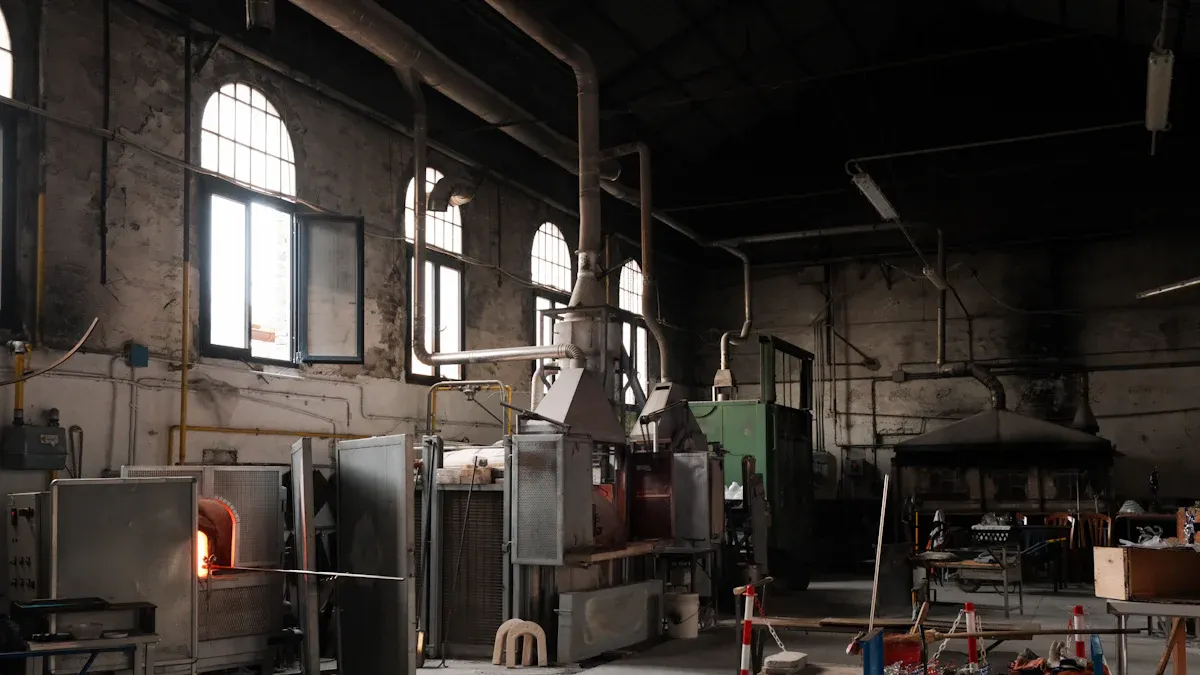The global glass shortage disrupts production for items like frying pan silicone universal lid, cookware glass lid, silicone glass lid, tempered glass lid, Oval glass lid, and rectangular glass lid.
- Shipping delays, rising demand, and labor issues challenge supply.
- In 2022, solar panel glass used 5% of float glass, straining availability.
Key Takeaways
- The global glass shortage happens because of supply chain problems, higher energy and material costs, and growing demand from many industries.
- This shortage causes delays, higher prices, and fewer choices for products like cookware lids, bottles, home windows, and car parts.
- Companies respond by using new materials, improving recycling, and adopting technology to manage supply and meet demand better.
Why the Global Glass Shortage Is Happening
Supply Chain Disruptions
Supply chain disruptions play a major role in the global glass shortage. Factories around the world have faced shutdowns and slowdowns, especially during the COVID-19 pandemic. Many glass manufacturers operated below normal capacity due to health and safety rules. Glass supply also shifted to support vaccine production, which left less glass for other industries.
Companies report longer lead times, higher prices, and frequent unavailability of glass products. In a 2023 industry report, 61% of respondents listed shortages of glass and other raw materials as a top supply chain problem.
Logistical challenges added on the problem. Material scarcity, rising freight costs, and communication issues among supply chain partners make it hard to keep glass moving smoothly. Many companies now use advanced tracking systems and real-time visibility tools to spot delays and manage shipments better. When these systems show a drop in delivery reliability, it signals trouble in the supply chain.
| Statistic/Factor | Data/Description |
|---|---|
| Global glass production (2020) | 690 billion units |
| Expected global glass production (2028) | 916 billion units |
| Market size (2023) | USD 189 billion |
| Projected market size (2033) | USD 309.8 billion |
| CAGR (2023-2033) | 5.2% |
| China glass exports (2022) | Nearly £27 billion |
These numbers show that demand keeps rising, but supply chain disruptions make it hard for manufacturers to keep up.
Increased Demand Across Industries
Demand for glass has surged in many sectors. The construction industry uses more glass for new buildings and renovations, especially as people remodel homes. The automotive sector needs glass for both regular and armored vehicles. Healthcare, retail, and education also require more glass for safety and security.
- The bulletproof glass market is growing fast, driven by needs in government, military, and commercial buildings.
- Asia Pacific leads in market growth, while North America holds the largest share.
- The drinkware market is expanding as hospitality venues open more locations. For example, Starbucks increased its stores from 33,833 to 38,027 in 2023.
- Tumblers and glasses are popular, with tumblers expected to grow at a 6.3% CAGR.
Industry expansions, such as Vitro’s $180 million facility adaptation, show how companies try to meet this rising demand. However, even with new investments, supply struggles to keep pace.
Production and Labor Challenges
Glass manufacturing faces several production and labor challenges. The industry needs skilled workers to operate advanced machines, but there is a shortage of trained tradespeople. Automation helps reduce manual labor, but it increases the need for workers with technical and digital skills.
- Employment in glass manufacturing recovered to about 400,000 workers by 2024, but workforce shortages remain.
- The Employment Cost Index for manufacturing compensation rose 3.8% year-over-year in 2024, showing higher labor costs.
- A 2024 study predicts that 1.9 million manufacturing jobs could stay unfilled over the next decade if talent shortages continue.
- Companies invest in apprenticeship programs and workforce management software to attract and keep workers.
High turnover rates and rising labor costs make it harder for manufacturers to maintain steady production. These challenges slow down output and add to the shortage.
Energy Costs and Raw Material Issues
Glass production depends on raw materials like silica sand, soda ash, and limestone. Silica sand alone makes up about 70% of the mix. Energy costs are high because glass furnaces must run at temperatures above 1500°C and hold up to 2,000 tons of molten glass.
- Raw material costs increased by 4.5% from the start of 2024 and 7.3% year-over-year.
- In Europe, supply shortages and higher raw material prices caused glass prices to rise, even as demand stayed strong.
- North America saw price hikes due to higher freight, packaging, and fuel costs.
- Using recycled glass can cut energy use by up to 30%, but recycling rates vary by region.
Small businesses struggle the most, as they cannot always pass on higher costs to customers. Project delays and increased imports of foreign glass also hurt local industries.
Manufacturers use advanced software to improve energy efficiency and reduce waste, but fluctuating costs and supply issues continue to create production difficulties worldwide.
Impact on Major Industries

Beverage and Food Packaging
The beverage and food packaging industry relies heavily on glass bottles and jars. Many companies use glass for its durability, safety, and ability to preserve flavor. The current shortage has forced manufacturers to delay production and limit product lines. Some beverage brands have reduced the number of bottle sizes they offer. Others have switched to alternative packaging, such as cans or plastic, to keep products on shelves.
Many breweries and wineries report that they cannot get enough glass bottles. This leads to higher prices for consumers and fewer choices in stores.
Restaurants and food producers also feel the impact. They face longer wait times for glass containers. Some must pay more to secure limited supplies. This situation creates challenges for small businesses that cannot compete with larger companies for scarce resources.
Construction and Real Estate
Construction and real estate depend on glass for windows, doors, facades, and interior features. The shortage has caused delays in building projects and increased costs for developers. Builders now pay more for glass panels and wait longer for deliveries.
The ‘Global Construction Glass Market Outlook to 2035′ shows that demand for construction glass keeps rising, especially in cities. Urbanization and sustainability trends drive this growth. The report highlights that supply chain problems and higher raw material costs push prices up. These factors make it harder for builders to finish projects on time and within budget.
The ‘Construction Materials Market Size | Global Industry Report 2032′ explains that supply chain disruptions and labor shortages slow down construction activity. COVID-19 lockdowns made these problems worse. Many projects faced delays and higher costs. Governments promote smart cities and green buildings, which increases demand for advanced glass products. However, regulatory and environmental challenges also limit supply.
| Factor | Impact on Construction and Real Estate |
|---|---|
| Urbanization | Increases demand for glass |
| Supply chain issues | Cause delays and higher costs |
| Raw material prices | Push up the cost of glass products |
| Labor shortages | Slow down project completion |
| Sustainability trends | Drive demand for smart and eco-friendly glass |
Automotive Manufacturing
Automotive manufacturing uses glass for windshields, windows, and sunroofs. The shortage has disrupted car production worldwide. Many automakers report that they cannot get enough glass parts to meet demand. This leads to slower assembly lines and fewer vehicles available for sale.
Car makers now look for ways to use glass more efficiently. Some companies redesign vehicles to use less glass or switch to different materials. The shortage also affects the repair market. Drivers may wait longer for replacement windshields or windows.
The automotive industry faces tough choices. Companies must balance quality, safety, and cost while dealing with limited glass supplies.
Healthcare and Pharmaceuticals
Healthcare and pharmaceutical industries need glass for medicine vials, syringes, and laboratory equipment. The pandemic increased demand for glass vials used in vaccines and treatments. This surge put extra pressure on glass manufacturers.
Hospitals and labs sometimes struggle to get enough glass containers. Delays in supply can affect patient care and research. Pharmaceutical companies must plan carefully to avoid running out of critical packaging.
Some manufacturers invest in new technology to produce glass faster and more efficiently. Others explore alternative materials, but glass remains the preferred choice for many medical uses due to its safety and chemical resistance.
Reliable glass supply is vital for healthcare. Shortages can disrupt treatment and slow down scientific progress.
Effects on Consumers and Everyday Products
Price Increases and Delays
Consumers now face higher prices for many glass products. The cost of glass bottles, jars, and containers has risen sharply. For example, some wine producers report that the price for a case of bottles jumped from $7 to over $9. Shipping fees and tariffs add to these costs. Many companies pass these increases on to shoppers. Delays have become common. Some wine producers wait up to 12 months for glass bottle shipments. These delays force businesses to store products longer, which raises expenses.
Many small producers struggle the most. They cannot compete with larger companies for limited glass supplies.
Product Shortages in Daily Life
Shoppers notice empty shelves where glass products once stood. The Global Glassware Market report shows that glassware and wine industries experience significant delays and scarcity. Panic buying by distributors and retailers makes shortages worse. When people see fewer products, they buy more, which creates a cycle of scarcity. Smaller brands often postpone bottling or use temporary storage because they cannot get enough glass. Manufacturing incidents, like oven failures at glass plants, also reduce supply.
- Wine bottles, jars, and glassware may be out of stock for weeks or months.
- Some stores limit how many glass items each customer can buy.
Changes in Packaging and Availability
Manufacturers adapted the situation by changing packaging. Some switch from glass material to plastic or metal containers. Others reduce the number of product sizes or shapes. These changes help keep products available but may affect quality or customer preference. Shoppers may see new packaging on familiar products or find fewer choices in stores.
| Change Type | Example |
|---|---|
| Material change | Glass to plastic bottles |
| Fewer options | Limited bottle sizes |
| New packaging | Alternative shapes or closures |
These shifts show how the glass shortage shapes what people find on store shelves every day.
The Case of Frying Pan Silicone Universal Lid and Kitchenware
How Glass Shortages Affect Kitchen Products ?
The global glass shortage has a direct impact on kitchenware. Many cookware items, such as the frying pan silicone universal lid, rely on tempered glass for durability and heat resistance. Manufacturers struggle to source enough quality glass for these products. As a result, production slows down, and fewer frying pan silicone universal lid options reach store shelves. Consumers notice higher prices and limited choices when shopping for replacement lids or new cookware sets.
Many kitchenware brands report delays in restocking popular items. The frying pan silicone universal lid often sells out quickly, leaving customers waiting for months. Some retailers place purchase limits on these lids to manage inventory.
Restaurants and home cooks both feel the effects. They depend on reliable lids to keep food fresh and prevent spills. The shortage forces some to use mismatched or ill-fitting covers, which can affect cooking results.
Alternatives and Adaptations in Cookware
Manufacturers respond to the shortage by exploring new materials and designs. Some companies create frying pan silicone universal lid models with more silicone and less glass. Others introduce lids made entirely from silicone or metal. These alternatives offer durability and flexibility, but they may not provide the same visibility as glass lids.
- Silicone lids fit a range of pan sizes and resist heat well.
- Metal lids last long but block the view of food while cooking.
- Some brands design multi-use lids to replace several traditional covers.
The frying pan silicone universal lid remains popular because it combines the benefits of glass and silicone. However, ongoing shortages push both brands and consumers to try new solutions.
Expert Insights and Industry Data
Key Statistics and Trends
Industry data shows that the global glass market continues to grow despite ongoing shortages. In 2022, the market reached $27.7 billion. Experts expect it to hit $44.3 billion by 2028, with a compound annual growth rate (CAGR) of 7.3%. This growth comes from strong demand in automotive and aerospace industries, where lightweight and durable glass composites play a key role.
| Aspect | Details |
|---|---|
| Market Size (2022) | USD 27.7 billion |
| Projected Market Size | USD 44.3 billion by 2028 |
| CAGR (2023-2028) | 7.3% |
| Demand Drivers | High demand from automotive and aerospace sectors for lightweight, durable composites |
| Current Constraints | Shortages of fiberglass cloth and liquid vinyl ester resin causing scarcity and price hikes |
| Market Restraints | Recycling issues, lack of standardization in manufacturing technologies |
| Opportunities | Growth in wind energy installations; rising demand in Middle East & Africa |
| Challenges | Capital-intensive production; competition from alternative materials |
| Market Insights | Patent trends, regional snapshots, competitive landscape highlighting supply constraints |
Shortages of fiberglass cloth and liquid vinyl ester resin have caused price hikes and limited supply. Recycling issues and a lack of standardization in manufacturing also slow down production. However, new opportunities appear in wind energy and growing markets in the Middle East and Africa.
Perspectives from Industry Leaders
Industry leaders point to several challenges and opportunities in the glass sector. Many executives highlight the capital-intensive nature of glass production. They note that competition from alternative materials, such as plastics and metals, puts extra pressure on manufacturers. Leaders also mention that patent trends and regional differences shape the competitive landscape.
“The industry faces a perfect storm of high demand and supply constraints,” says one manufacturing executive. “Companies must innovate and invest in new technologies to stay ahead.”
Some leaders see growth in wind energy installations as a bright spot. They believe that rising demand for durable glass composites in renewable energy will drive future investment. Others stress the need for better recycling systems and more standardized manufacturing processes to ease supply chain pressures.
Future Outlook and Solutions
Short-Term Expectations
Industry experts predict that the global glass shortage will continue in the near future. Many manufacturers expect supply chain issues to last through the next year. Companies plan to manage these challenges by adjusting production schedules and prioritizing high-demand products. Some businesses will continue to limit the variety of glass items they offer.
Note: Consumers may see higher prices and fewer choices for glass products in stores. Delays in delivery times will likely remain common.
Retailers and producers will focus on better inventory management. They may use digital tools to track supplies and forecast demand more accurately. Small businesses might struggle more than large companies because they have less buying power.
| Short-Term Action | Expected Result |
|---|---|
| Adjusting production | Fewer product options |
| Inventory tracking tools | Improved supply planning |
| Price adjustments | Higher costs for consumers |
Innovations and Long-Term Strategies
Many companies invest in new technologies to solve the glass shortage. Some manufacturers use advanced recycling methods to turn old glass into new products. Others develop energy-efficient furnaces that lower production costs and reduce waste.
- Research teams explore alternative materials, such as reinforced plastics or ceramics, for certain uses.
- Automation and robotics help factories produce glass faster and with fewer workers.
- Industry leaders form partnerships to share resources and knowledge.
Tip: Companies that innovate and adapt will likely recover faster and stay competitive.
In the long term, experts believe that better recycling systems and smarter manufacturing will help balance supply and demand. These changes could make glass products more available and affordable for everyone.
The global glass shortage results from supply chain disruptions, rising energy and raw material costs, and shifting consumer preferences. Market data highlights these trends:
| Aspect | Key Insight |
|---|---|
| Trade Contraction | Crystal glass trade fell 7.3% (2020–2022) |
| Energy Costs | Europe’s energy prices rose 40% in 2022 |
| Consumer Preferences | 60% luxury buyers want eco-friendly products |
Businesses should monitor costs and diversify suppliers. Consumers can try alternative materials or buy in bulk to save money.
FAQ
What causes the global glass shortage?
Many factors drive the shortage. Supply chain disruptions, rising energy costs, and increased demand across industries all contribute. Manufacturers struggle to keep up with orders.
How does the glass shortage affect daily life?
People see higher prices and fewer choices for glass products. Stores may run out of glass bottles, jars, or cookware. Some brands switch to alternative packaging.
Can companies solve the glass shortage soon?
Experts say the shortage may last into next year. Companies invest in recycling, automation, and new materials to improve supply, but quick solutions remain unlikely.
Post time: Jun-20-2025

